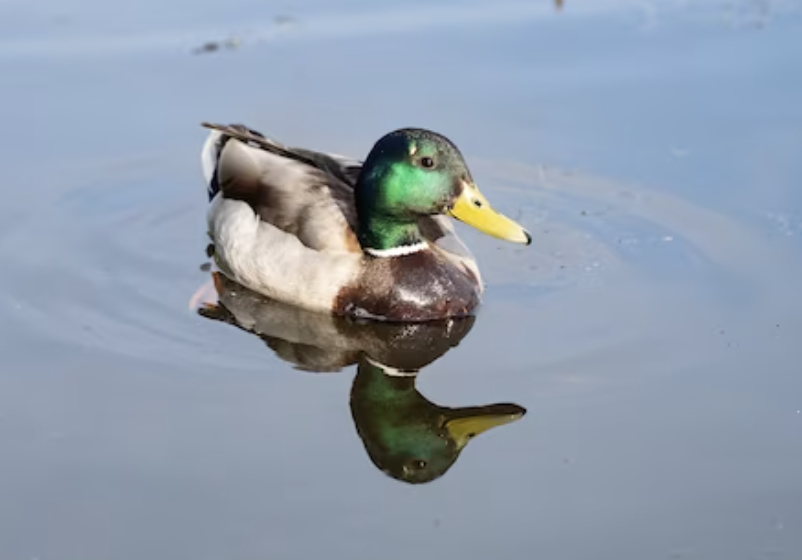For most of the year, it’s hard to find a pond without at least a few mallards swimming around.
These ducks, with their green-headed drakes and streaky brown hens, are among the most common water birds throughout the Northeast. In spring and fall, mallard flocks are ubiquitous, gobbling up grasses and aquatic plants. In winter, as ice spreads across most ponds, many of these flocks fly south, while the few that remain retreat to open water wherever they can find it. And in summer, if you’re lucky, you might see a female swimming with a trail of downy ducklings behind her.
As late summer rolls around, however, one thing you’re not apt to see is a male mallard. Scan a flock of ducks in July or August and, more often than not, every single one will have the drab plumage of a female. Not a green head in sight. What happened? Where did all the males go?
As it turns out, they never left. The males are simply hiding, sometimes within those same flocks, disguised as females.
Nearly all birds molt at least once a year, shedding their old feathers as new ones grow in to replace them. Molting usually takes several weeks, during which birds can appear ratty or even injured. If you’ve ever seen a vulture or hawk missing a bunch of its wing feathers, molting is often the explanation. As those soaring raptors make clear, however, birds can usually still fly when they are molting.
Female mallards molt in this same fashion, replacing their feathers gradually during the spring. For male mallards – and some other species of waterfowl – molt is a bit more intense. Shortly after the breeding season ends and the males have sired offspring, they shed their feathers fast, so fast that new flight feathers can’t grow in quickly enough to keep up. For a brief period of time, this leaves the ducks unable to fly.
Naturally, this period of flightlessness makes these birds vulnerable to predators. So, male ducks go into hiding and retreat towards the centers of big marshy lakes to molt. If they simply replaced their old feathers with more of their typical flashy plumage, these males would still be an easy target for any passing red fox or red-tailed hawk. Instead, they grow an intermediary set of feathers called eclipse plumage, which appears nearly identical to the streaky brown patterning of females. Since males’ wing feathers grow in later than the rest of their feathers, this plain plumage helps to keep the male ducks hidden from predators during this especially vulnerable period.
You may begin to notice male mallards looking ratty in late June, just as their big molt starts to kick in. July and August are peak eclipse plumage season, but eventually ducks will molt these feathers as well. By the beginning of September, male mallards begin to look more like we expect them to. Green plumage spreads across their faces, their breasts turn rich brown, and their sides regain their typical silvery plumage. By October, they have returned to their bright, green-headed glory.
Distinguishing female mallards from males during summer can be tricky. Male mallards do retain a few key plumage features during the summer, though: their breasts are warmer brown than females’, their plumage looks messier, and they retain just a touch of green on their heads – in stripes on the crown and behind the eye.
Mallards are not the only ducks in our region that undergo this stark summer transformation. Wood duck males, too, adopt a drab plumage, shedding their bright headdresses and shiny body feathers in exchange for subdued grays and browns. Male hooded mergansers lose their hoods, and male common mergansers swap their green heads and stark white bodies for a simpler brown and gray plumage.
In general, your best clue to identify male ducks in eclipse plumage is to look at the parts of the bird’s body that have no feather covering at all, namely the bill and eyes. If you see a “female” mallard with a yellow bill, chances are it’s really a male. In a similar sense, if you see a wood duck with a red bill and red eye, or a hooded merganser with a yellow eye and all-black bill, those are males in disguise as well.
William von Herff is a scientist-turned-science writer who writes about conservation, the environment, and natural history. He is currently pursuing his M.S. in the Graduate Program in Science Writing at the Massachusetts Institute of Technology. Illustration by Adelaide Murphy Tyrol. The Outside Story is assigned and edited by Northern Woodlands magazine and sponsored by the Wellborn Ecology Fund of the New Hampshire Charitable Foundation: nhcf.org.




